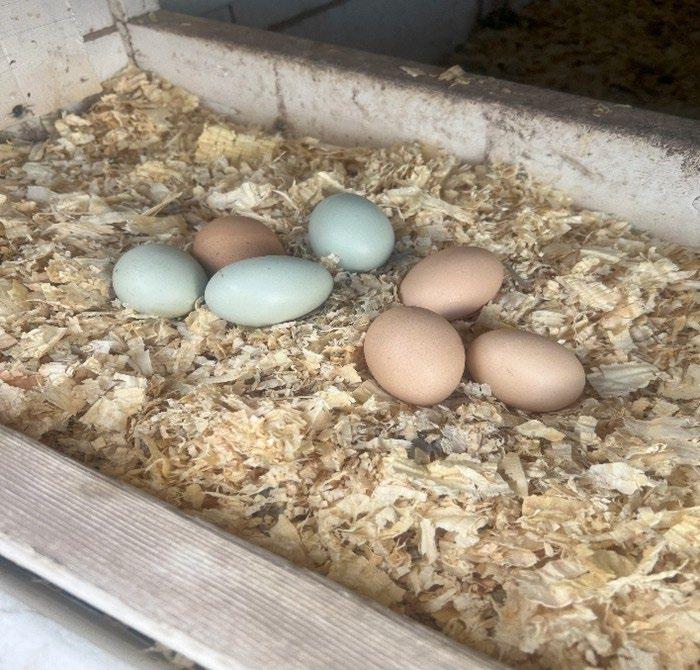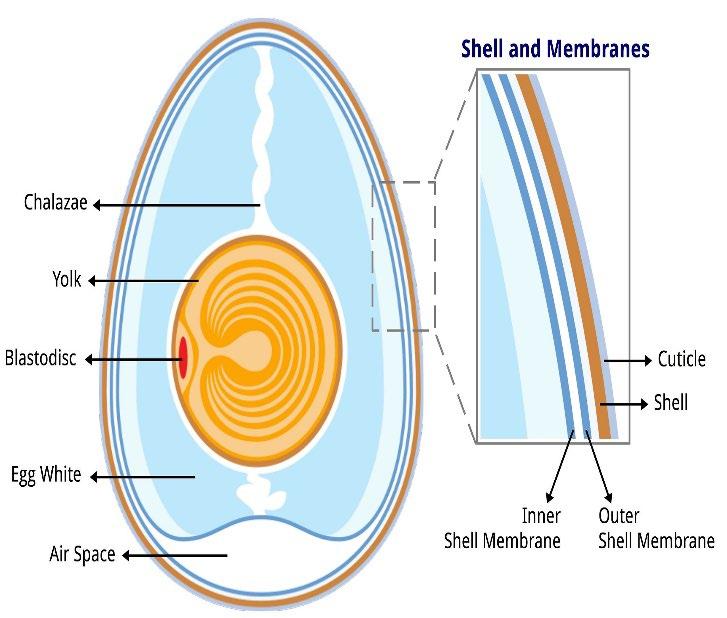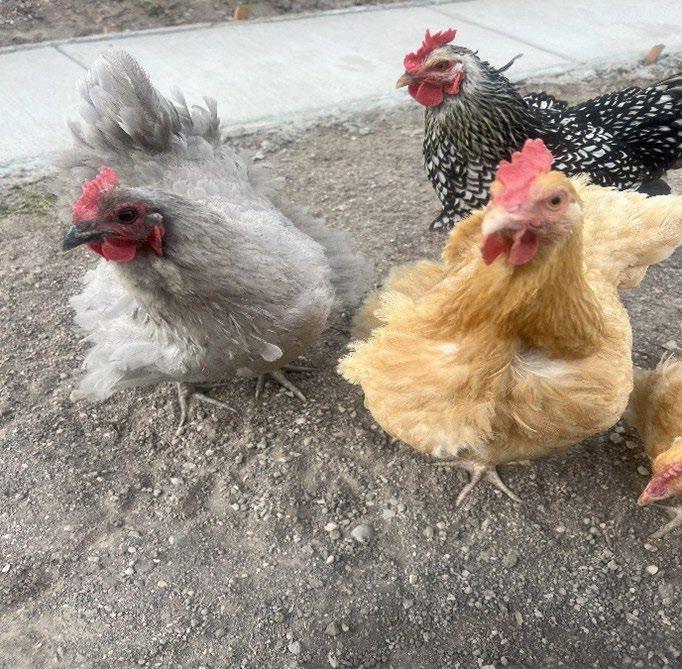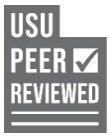

A Farmer’s Guide to Egg Quality, Safety, and Flock Health
Joseph Okoh , USU Extension Small Ac reage Livestock Specialist
Essence Perry, Intern, Department of Animal, Dairy, and Veterinary Sciences
Introduction
Eggs are a valuable source of nutrition and income for many backyard and smallholder farmers. To ensure a steady supply of high-quality eggs, it's essential to understand the key factors that influence hens’ health and productivity. From proper nutrition to effective lighting and disease prevention, each decision you make affects your flock’s performance. This guide offers practical advice to help you raise resilient, high-laying hens and build a successful small-scale egg production system, no matter your level of experience.
Egg Anatomy and Composition
The egg is a self-contained structure made up of key parts like the shell, membranes, egg white (albumen), and yolk. Each part plays a role in protection, nutrition, and development (Figure 1)
Yolk: Contains fats (mostly triglycerides), proteins, cholesterol, and vitamins. It holds about 49% water, 33% fat, and 16% protein. Fatty acid content can be altered through the hen’s diet.
Albumen (egg white): Made of 88% water and various proteins (mainly ovomucin and lysozyme, an antibacterial enzyme). It’s the main water reservoir in the egg.
Shell Membranes: Two layers that help protect the egg and regulate moisture and gas exchange.
Shell: Strong yet porous, it protects the embryo but allows air in. Shell thickness affects strength and varies with age and bird type.
Component Yields (by average weight)
• Albumen and chalazae: 64%
• Yolk: 27%
• Shell and Membranes: 9.5% (Cherian et al., 2002)


Highlights
• The egg is a self-contained structure made of the shell, membranes, egg white (albumen), and yolk.
• Eggs are a nutrient-dense food, providing essential vitamins, minerals, high-quality protein, and healthy fats
• Egg defects can occur due to nutritional issues, diseases, environmental stress, or genetic factors
• Eggs are highly perishable and require specific handling methods to ensure they remain safe to eat.
• Bird health directly affects their productivity, growth rate, egg production, and overall farm profitability. Detect health issues early to prevent disease spread, reduce losses, and ensure animal welfare.



Egg Nutrition and Health
Eggs are a nutrient-dense food, providing essential vitamins, minerals, high-quality protein, and healthy fats that help individuals stay strong and energized for demanding work. They support muscle strength, brain health, and overall wellbeing. While there were past concerns about cholesterol, recent research shows eggs can be safely enjoyed as part of a healthy diet.
• Eggs are rich in high-quality protein, unsaturated fats, and essential vitamins (A, D, B12) and minerals like iron and phosphorus.
• Eggs contain all essential vitamins except Vitamin C.
• Egg yolks cholesterol is high, with a single chicken egg holding about 270 mg, while duck eggs can have nearly 620 mg! Interestingly, studies suggest that for most people, the cholesterol we get from eggs doesn’t really interfere with our blood cholesterol levels all that much. Our bodies could adjust to their own cholesterol production in response. There are a few people, known as “hyper-responders,” who might see a bigger spike in their blood cholesterol after eating eggs. However, for most healthy people, enjoying eggs as part of a balanced diet is perfectly fine and won’t significantly raise cardiovascular risk (FoodData Central, 2019; Kanter et al., 2012).
Egg Safety and Quality
Microbial Risks
Ensuring egg safety and quality is crucial due to the potential microbial risks that can compromise both consumer health and product integrity.
• Intact shells are natural barriers against bacteria The outer shell acts as a protective layer that helps keep harmful bacteria from entering
• Cracked, dirty, or broken eggs can be contaminated easily because the eggshell is a natural barrier that protects against bacteria like salmonella. When the shell is damaged or soiled, bacteria can easily enter and contaminate the inside of the egg. This increases the risk of foodborne illness, especially if the egg is not cooked properly.

Source: Wikimedia Commons
• Albumen (egg white) contains lysozyme, which helps kill invading bacteria. It helps protect the egg by attacking certain bacteria that try to enter. These bacteria, called gram-positive, have thick outer walls. Lysozyme breaks down those walls, making the bacteria burst and die. This helps keep the egg fresh and safe, especially before it hatches or is eaten.
Common Egg Defects
Egg defects can occur due to nutritional issues, diseases, environmental stress, or genetic factors. These defects may affect the shell, albumen (egg white), yolk, or the egg’s overall shape. If the defect affects the shell, it is referred to as an external issue or defect, but if it affects the albumen, yolk, or both, it is considered an internal issue or defect.
Figure 1. Egg Anatomy
External Defects
Shell Defects
a. Thin or Soft Shells
This may be caused by a deficiency of calcium or vitamin D, heat stress, or using hens that are too young or too old. As a result, the eggs can break easily and offer poor protection against external threats like bacteria. To prevent this, provide adequate calcium (e.g., crushed oyster shells) and a balanced diet.
b. Shell-less Eggs
This defect can result from sudden stress in the laying hen, very young layers, or calcium imbalance. The outcome is usually an egg with only a membrane and a transparent appearance, lacking a shell. To reduce or eliminate this issue, it is important to minimize stress by supplying adequate temperature, light, feed, water, and keeping human interaction steady and predictable. Reducing sudden changes, overcrowding, and disease risks will significantly minimize stress and improve both welfare and production.
c. Cracked or Broken Shells
This is usually caused by overcrowding, if birds have less than 1.5 to 2 square feet per hen indoors (floor systems) or less than 750 square centimeters in cages, it’s overcrowded (Food and Agriculture Organization [FAO], 2003). Rough handling of eggs or weak shells could cause breakage. Solutions include better nest design, gentler egg collection, and adequate calcium supplementation for strong eggshells. Laying hens require 3.25% to 4.5% calcium in the diet, depending on the stage of production. Commercial and Extension guidelines generally recommend 3.5% to 4.0% calcium (35–40 g/kg of feed), which provides an average daily intake of 3.5–4.5 g of calcium per hen (Roberts, 2004).
d. Misshapen or Wrinkled Shells
This condition is often caused by infectious diseases, such as infectious bronchitis, stress, or genetic factors. To prevent it, improve disease control in laying hens by adhering to strong biosecurity, proper vaccination, and good hygiene. Adequate nutrition, stress reduction, and regular flock monitoring with veterinary support help maintain health and productivity (Saif, 2013) and overall flock management. Remove affected birds if the issue becomes chronic.
e. Flat-sided Eggs
If there is pressure in the oviduct due to overcrowding of eggs or double ovulation, the egg may be laid with a flat side. This situation often occurs in young pullets under stress conditions (Roberts, 2004). Reducing flock stress and ensuring proper management are key to preventing this condition.
f. Pimpled or Rough Shells
This can occur if hens are fed excess calcium, leading to poor shell formation. The solution is to maintain a balanced mineral content in feed and avoid over-supplementation (see “c. Cracked or Broken Shells”)
g. Discolored Shells
Eggshell discoloration in chickens happens when the process of pigment deposition in the shell gland gets thrown off. This can be due to various factors like age, stress, diseases (such as infectious bronchitis), nutritional gaps, or even genetics. Fortunately, it can be fixed by ensuring the chickens get a well-rounded diet rich in essential minerals and vitamins, reducing stress levels, keeping up with good biosecurity and vaccination practices, and choosing breeds known for their consistent shell color (Roberts, 2004).
Internal Defects
a. Watery Albumen (Egg White)
Watery albumen can be a result of several factors, including the age of the hen, high temperatures, or even disease. This leads to lower-quality eggs that don’t store well and have less nutritional value. To help prevent this issue, make sure to keep your hens cool, provide them with well-ventilated housing, ensure they have plenty of fresh water, and manage their age by replacing older birds that have been laying for a long time and taking care of their health.
b. Blood Spots
Blood spots in chicken eggs happen when tiny blood vessels break during the release of the yolk. This can be caused by factors like genetics, stress, or inadequate nutrition. To manage this issue, it's important to provide a balanced diet that includes plenty of vitamin A (maintains epithelial tissue and reproductive tract health),
vitamin K (essential for blood clotting and reducing hemorrhage), and vitamin C (strengthens blood vessel walls and reduces capillary fragility). Keep lighting conditions consistent, minimize stress, choose breeds that are less prone to this problem, and candle the eggs to remove any that are affected before they go to market.
c. Meat Spots
These are small pieces of tissue or pigment found in the egg. They are not harmful but are visually unappealing. Typically, they come from the oviduct or the yolk itself. You can minimize their occurrence by ensuring good flock health, keeping up with vaccinations, managing stress, selecting for better genetics, and culling older birds. Candling can help you spot and remove any affected eggs before they go to market.
d. Double Yolks
Double-yolk eggs happen when a hen releases two yolks into the oviduct almost simultaneously, a phenomenon called double ovulation. This is most frequently seen in young pullets whose reproductive systems are still developing, but factors like genetics, breed selection, nutrition, and hormonal imbalances can also play a role. Hens that are on high-energy diets or experiencing stress might be more likely to lay double-yolk eggs. These eggs are completely safe to eat and have the same nutritional value as regular eggs, but they are not suitable for hatching since they rarely develop into chicks. From a production standpoint, double-yolk eggs are often seen as a fun novelty in the table egg market, but they’re not ideal for hatcheries. To reduce their occurrence, management practices like controlled lighting, balanced nutrition to prevent overweight pullets, stress management, and careful genetic selection can be beneficial. While double-yolk eggs pose no harm to hens or humans, good flock management can help keep their numbers down and promote more consistent egg production.
e. Off-Colored or Off-Flavored Yolks
Off-colored yolks in chickens typically happen when their diet lacks carotenoid pigments like xanthophylls, lutein, and zeaxanthin, which are key for giving yolks their color. When chickens eat heavy in wheat or barley, their yolks tend to be paler. On the flip side, ingredients like corn, alfalfa meal, marigold petals, or even synthetic pigments like canthaxanthin can boost yolk color. Factors like poorquality feed, feed withdrawal, rancid fats, or diseases that hinder nutrient absorption can also lead to lighter yolks.


As for off-flavored yolks, they often come from strong-smelling feed ingredients such as fish meal, garlic, onions, or rapeseed, as well as rancid or oxidized fats. Metabolic issues, like the buildup of trimethylamine (TMA) in some brown-egg layers, or eggs soaking up odors from chemicals and poor storage conditions can also be culprits. To tackle these issues, it's important to provide a balanced diet rich in fresh, stable fats and carotenoids, steer clear of tainting ingredients for sensitive breeds, keep the flock healthy to aid in pigment absorption, store eggs in clean, odor-free spaces, and choose genetic strains that are less likely to have TMArelated problems.
Egg Quality
Good egg quality is important for both farmers and consumers. It means fewer broken or dirty eggs, which sell better Strong, clean eggs are safer to eat and look more appealing. They also taste better and have more nutrients. For farmers, egg quality can show if the chickens are healthy and well cared for. Keeping egg quality high helps build trust, follow food rules, and keep businesses running smoothly.
Egg quality can be classified as external or internal, depending on what is being evaluated. External quality refers to the shell’s appearance and strength, while internal quality involves examining the yolk and albumen (egg white).
External Quality
External quality includes weight, shape, shell integrity, and thickness. Shell thickness and strength depend on bird health, diet, age, and environment. Good shell quality prevents breakage, moisture loss, and bacterial invasion but must be sufficiently porous for hatching.
Internal Quality
Internal quality includes healthy albumen (egg white) Height and firmness indicate freshness, as measured via Haugh units. pH rises as eggs age, weakening albumen.
As for the yolk, height-to-diameter ratio (yolk index) drops with age. Color reflects diet; darker yolks often mean more nutrients like carotenoids and omega-3s. The yolk color depends on the hen's diet, specifically pigments called xanthophylls. Rich yellow yolks come from maize or pasture feeding. Wheat- or rice-based feeds may require color additives if deep yellow yolks are desired.
Storage and Quality Changes
As eggs age:
• They lose water (mainly through the shell).
• Air cells enlarge, indicating age.
• Albumen becomes thinner due to changes in protein interactions.
• pH rises from about 7.6 to about 9.2 after 2 weeks. These changes affect egg freshness, texture, and suitability for certain recipes.
Shell Strength and Breakage
• Around 7% of eggs break during collection or transport.
• Thicker shells and more rounded shapes are stronger.
• Shell strength declines as hens age.
• Proper nutrition, especially adequate calcium and vitamin D, and optimal lighting help maintain shell quality.
Safe Egg Storage Methods
Proper egg storage is essential to maintain freshness and prevent the risk of foodborne illness. Eggs are highly perishable and require specific handling methods to ensure they remain safe to eat. By following recommended storage practices, you can extend their shelf life and reduce the risk of contamination (Table 1).
Refrigeration In original carton, ≤ 40 °F 3–5 weeks (raw), 1 week (boiled) Don't wash before storing
Freezing Crack and beat, add salt/sugar Up to 1 year
Pickling Hard-boil, store in vinegar 3–4 months
Dehydrating Scramble and dry cooked eggs Up to 1 year
Never freeze in shell
Keep refrigerated
Store airtight
Mineral oil Coat with food-grade oil 3–4 weeks (room), 3+ months (fridge) Store pointed-end down
Table 1. Some Common Practices for Storing Eggs
Egg Weight and Grades
Eggs are graded to indicate quality and freshness. Eggs are graded based on:
• Interior quality (condition of the albumen or egg white and yolk).
• Exterior quality (shell condition).
• Size and weight (standardization).
There are three primary grades employed by the U.S. Department of Agriculture (USDA). An egg receives a grade of AA, A, or B as follows:
1. Grade AA – This is the highest quality grade. Eggs have a clean, unbroken shell and are practically normal. The albumen (egg white) is thick and firm, standing high when broken out, and the yolk is round, high, and practically free from defects. These eggs are best for culinary uses where frying and appearance matter.
2. Grade A – This is also a high-quality grade, slightly lower than AA. The shell is clean and unbroken, and the albumen is reasonably firm but may be less thick than Grade AA. The yolk is fairly high and free from major defects.
3. Grade B – These are lower-quality eggs. The shell may have minor stains or slight defects but is not cracked. The albumen is usually thinner and less firm, and the yolk may be flattened or have minor defects.
Egg Size
Size is an important factor for both consumers and producers, influencing cooking results, packaging, and pricing. Eggs are commonly classified into size categories based on their weight, ranging from small to jumbo (Table 2). These size distinctions help ensure consistency in recipes and provide a standardized way for buyers to select eggs according to their needs. Understanding egg sizes is especially useful for culinary applications, where precise measurements can affect the texture and outcome of dishes. Whether you’re baking, frying, or boiling, knowing the size of the egg can make a noticeable difference in your cooking.
Table 2: Sizes and Egg Weights
Jumbo 70 +
Extra large 63–69
Large 56–62
Medium 49–55
Small 42–48
Peewee Less than 42
Monitoring Bird Health

Monitoring bird health is a critical aspect of successful poultry management (Figure 2). The health of birds directly affects their productivity, growth rate, egg production, and overall farm profitability. Detecting health issues early helps prevent the spread of disease, reduces losses, and ensures animal welfare (Table 3). By regularly observing bird behavior, physical condition, and performance indicators, farmers can take timely action to maintain a healthy flock and sustain optimal production levels. Producers should:
• Check egg count and shell quality daily.
• Watch for abnormal droppings or appetite changes.
• Look for eye/nasal discharge, limping, or huddling.
• Check under wings at night for mites.
Table 3. Common Illnesses and Symptoms
Disease Symptoms Cause Spread
Coccidiosis Bloody droppings, weakness
Newcastle disease Sneezing, twisted neck
Avian influenza Sudden death, purple comb
Infectious bronchitis Watery eyes, poor eggs
Fowl pox Warts on comb, mouth sores
Marek’s disease Paralysis, eye issues
CRD (Mycoplasma) Cough, eye swelling
Egg drop syndrome Shell-less eggs
Lice and mites Feather loss, scabs
Health and Biosecurity
• Quarantine new birds (30 days)
• Disinfect tools, boots, and feeders
• Keep wild birds and rodents out of the coop
• Use vaccines when recommended
First Aid Kit Suggestions
• Electrolytes (e.g., Sav-A-Chick™).
• Wound spray (e.g., Vetericyn).
• Dewormers (e.g., Safeguard®).
• Poultry dust for mites.
• Isolation crate for sick birds.
Keeping Layers Healthy
• Clean the coop regularly
• Keep food and water fresh
• Vaccinate as needed
• Monitor eggs and droppings
• Quarantine sick birds early
• Record all health and performance data
Who to Call
Parasite Infected litter
Virus Air, feces, tools
Virus Wild birds, humans
Virus Airborne
Virus Mosquitoes
Virus Feather dust
Bacteria Close contact
Virus Tools, wild birds
Parasites Contact with infested areas

• Local poultry labs may help; many offer low-cost testing.
• Contact your county Extension office: https://extension.usu.edu/locations
Conclusion
Success in egg farming is not just about collecting eggs; it’s about creating the right conditions for your birds to thrive. From shell strength to yolk quality, every egg tells a story of how well your flock is fed, housed, and cared for. By understanding the process behind egg formation, recognizing common defects, and prioritizing bird health and hygiene, you can significantly improve both the quantity and quality of eggs produced.
Figure 2. Interaction Between Backyard Chickens and Caregiver
Photo courtesy of Chad Page, Utah State University
A vigilant eye on nutrition, disease prevention, and storage methods transform eggs from a daily chore into a reliable income stream and nutritional powerhouse. Remember, healthy hens lay healthy eggs, and healthy eggs build healthy communities.
References
Agricultural Marketing Service. (2020). United States standards, grades, and weight classes for shell eggs. United States Department of Agriculture (USDA). https://www.ams.usda.gov/grades-standards/shell-egg-grades-and-standards Centers for Disease Control and Prevention. (2020, February 13). Salmonella and eggs. U.S. Department of Health and Human Services. https://www.cdc.gov/features/salmonellaeggs/ Cherian, G., Holsonbake, T. B., & Goeger, M. P. (2002). Fatty acid composition and egg components of specialty eggs. Poultry Science, 81(1), 30–33. https://doi.org/10.1093/ps/81.1.30.
Food and Agriculture Organization (FAO). (2003). Good practices in the management of laying hens on free range and semi-intensive systems. In Small-scale poultry production (FAO Animal Production and Health Manual, 1). Rome: FAO. Retrieved from https://www.fao.org/4/y5169e/y5169e05.htm
Food and Agriculture Organization (FAO). (2014). Small-scale poultry production: Technical guide (FAO Animal Production and Health Manual No. 1). https://www.fao.org/3/y5169e/y5169e00.htm
Food and Agriculture Organization and World Health Organization. (2002). Risk assessments of Salmonella in eggs and broiler chickens. https://www.fao.org/3/y4393e/y4393e.pdf
FoodData Central. (2023). Egg, whole, raw, fresh. Agricultural Research Service, United States Department of Agriculture. https://fdc.nal.usda.gov/
FoodData Central. (2019). Eggs, whole, raw, fresh. Agricultural Research Service, U.S. Department of Agriculture. https://fdc.nal.usda.gov/
Kanter, M. M., Kris-Etherton, P. M., Fernandez, M. L., Vickers, K. C., & Katz, D. L. (2012). Exploring the factors that affect blood cholesterol and heart disease risk: Is dietary cholesterol as bad for you as history leads us to believe? Advances in Nutrition, 3(5), 711–717. https://doi.org/10.3945/an.112.002303
Merck Veterinary Manual. (2024). Diseases of poultry. Merck & Co., Inc. https://www.merckvetmanual.com/ National Research Council (NRC). (1994). Nutrient requirements of poultry: Ninth revised edition. National Academies Press. https://doi.org/10.17226/2114
Roberts, J. R. (2004). Factors affecting egg internal quality and eggshell quality in laying hens. Journal of Poultry Science, 41(3), 161–177. https://doi.org/10.2141/jpsa.41.161
Saif, Y. M. (Ed.). (2013). Diseases of poultry (13th ed.). Wiley-Blackwell.
In its programs and activities, including in admissions and employment, Utah State University does not discriminate or tolerate discrimination, including harassment, based on race, color, religion, sex, national origin, age, genetic information, sexual orientation, gender identity or expression, disability, status as a protected veteran, or any other status protected by University policy, Title IX, or any other federal, state, or local law. Utah State University is an equal opportunity employer and does not discriminate or tolerate discrimination including harassment in employment including in hiring, promotion, transfer, or termination based on race, color, religion, sex, national origin, age, genetic information, sexual orientation, gender identity or expression, disability, status as a protected veteran, or any other status protected by University policy or any other federal, state, or local law. Utah State University does not discriminate in its housing offerings and will treat all persons fairly and equally without regard to race, color, religion, sex, familial status, disability, national origin, source of income, sexual orientation, or gender identity. Additionally, the University endeavors to provide reasonable accommodations when necessary and to ensure equal access to qualified persons with disabilities. The following office has been designated to handle inquiries regarding the application of Title IX and its implementing regulations and/or USU’s non-discrimination policies: The Office of Equity in Distance Education, Room 400, Logan, Utah, titleix@usu.edu, 435-7971266. For further information regarding non-discrimination, please visit equity.usu.edu, or contact: U.S. Department of Education, Office of Assistant Secretary for Civil Rights, 800-421-3481, ocr@ed.gov or U.S. Department of Education, Denver Regional Office, 303-844-5695 ocr.denver@ed.gov. Issued in furtherance of Cooperative Extension work, acts of May 8 and June 30, 1914, in cooperation with the U.S. Department of Agriculture, Kenneth L. White, Vice President for Extension and Agriculture, Utah State University. July 2024 Utah State University Extension

October 2025
Utah State University Extension Peer-reviewed fact sheet
